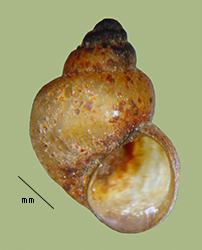> Habitat & Distribution
Hershler & Thompson (1996) mapped over 100 well-documented records of C. integra throughout North America, which they summarized as "broadly distributed within the drainage of the Mississippi River and large tributaries (e.g., Missouri, Ohio Rivers). Also in Great Lakes - St. Lawrence River, southern Great Plains, and Gulf Coastal drainages from Texas through western Alabama." We have confirmed populations in the Chattahoochee/Apalachicola of Georgia, widespread in drainages of The Ohio (proper), and spotty in The Great Plains.
Our data suggest that Cincinnatia populations are rare in drainages of the Tennessee/Cumberland. Hershler & Thompson transmited three extra-limital reports from middle Atlantic drainages which they noted "require confirmation." We have been unable to confirm any Atlantic-drainage records of Cincinnatia ourselves.
Throughout their wide range, populations of C. integra typically seem to inhabit soft, silty bottoms, often in deeper waters. FWGNA incidence rank I-3p, peripheral.
> Ecology & Life History
Cincinnatia are sometimes referred to as "siltsnails." Berry (1943) observed that populations of C. integra and Amnicola limosa seemed to divide the habitat in one small Michigan stream, the former inhabiting "soft muddy ooze" and the latter inhabiting more rapidly-flowing reaches, where aquatic vegetation was present. Berry reported that the gut contents of C. integra consisted "mainly of diatoms."
> Taxonomy & Systematics
"Paludina" integra was one of 17 species of freshwater prosobranchs described by Thomas Say in his first heroic efforts to catalog the North American malacofauna, 1817 - 1821. But for 150 years there was no consensus as to whether Say was holding in his hand the viviparid that became Campeloma integra or the hydrobiid that became Cincinnatia integra. Hershler & Thompson (1996) finally resolved the issue in favor of the latter argument, publishing a scholarly review of the hydrobiid's systematics, anatomy, and distribution, synonymizing cincinnatiensis (Anthony) and several less well-known subsequent nomina underneath integra.
Cincinnatia belongs to the subfamily Nymphophilinae of the family Hydrobiidae (ss), males being characterized by a lobe-shaped penis (or verge) with surficial glandular patterns (Kabat and Hershler 1993). Although Thompson (1968) initially considered Cincinnatia a large and inclusive genus, details of the female reproductive anatomy ultimately prompted Thompson & Hershler (2002) to reduce it to monotypy.
One of the very few evaluations of intraspecific genetic and morphological variation available for any North American hydrobioid was conducted on seven populations of Cincinnatia integra by Hershler and colleagues (2011). With a sample total of 25 from the seven populations combined, mean CO1 sequence divergence among C. integra from Mexico and four US states was reported to range up to 2.6%.
> Maps and Supplementary Resources
- Cincinnatia distribution in the drainage of The Ohio (2019)
- Cincinnatia in the Tennessee/Cumberland drainages (2022)
- Hydrobioid distribution in The Great Plains (2024)
- Cincinnatia in Georgia and the Florida panhandle (2025)
> Essays
- Earlier versions of this website, online until August of 2016, adopted the large, broadly-inclusive concept of the Hydrobiidae (sl) following Kabat & Hershler (1993). More recently the FWGNA project has shifted to the Wilke et al. (2013) classification system, distinguishing a much smaller Hydrobiidae (ss) and elevating many hydrobioid taxa previously ranked as subfamilies to the full family level. For more details, see The Classification of the Hydrobioids.
> References
Berry, E.G. (1943) The Amnicolidae of Michigan: distribution, ecology, and taxonomy. Misc. Publ. Mus. Zool. U. Mich., 57: 1-68.
Dillon, R. T., Jr. (2000) The Ecology of Freshwater Molluscs. Cambridge, Cambridge University Press. 509 pp.
Hershler, R. (1994) A review of the North American freshwater snail genus Pyrgulopsis (Hydrobiidae). Smithsonian Contributions to Zoology 554:1-115.
Hershler, R., H. Liu, and F.G. Thompson (2003) Phylogenetic relationships of North American nymphophiline gastropods based on mitochondrial DNA sequences. Zoologica Scripta 32:357-366.
Hershler, R. & F.G. Thompson (1996) Redescription of Paludina integra Say, 1821, type species of genus Cincinnatia (Gastropoda: Hydrobiidae). J. Moll. Stud. 62: 33 - 55.
Hershler, R., F.G. Thompson & H-P. Liu (2011) A large range extension and molecular phylogenetic analysis of the monotypic North American aquatic gastropod genus Cincinnatia (Hydrobiidae). J. Moll. Stud. 77: 232 - 240.
Kabat, A.R., and R. Hershler (1993) The prosobranch snail family Hydrobiidae (Gastropoda: Rissooidea): review of classification and supraspecific taxa. Smithsonian Contributions to Zoology 547:1-94.
Thompson, F.G. (1968) The Aquatic Snails of the Family Hydrobiidae of Peninsular Florida. University of Florida Press, Gainesville, Florida, USA.
Thompson, F. G. & R. Hershler (2002) Two genera of North American freshwater snails: Marstonia Baker, 1926, resurrected to generic status, and Floridobia, new genus (Prosobranchia: Hydrobiidae: Nymphophilinae). The Veliger 45: 269 - 271.
Wilke T., Haase M., Hershler R., Liu H-P., Misof B., Ponder W. (2013) Pushing short DNA fragments to the limit: Phylogenetic relationships of hydrobioid gastropods (Caenogastropoda: Rissooidea). Molecular Phylogenetics and Evolution 66: 715 736.








